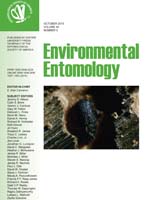The lacewing Chrysopa phyllochroma Waesmael is a polyphagous predator of many pests. Releasing lacewings is an important component of biological control programs, but it is difficult to establish populations on field crops. Electrophysiological and behavioral responses to 10 common plant volatiles were recorded to screen for lacewing-attracting compounds. Electroantennographic assays indicated that all of the tested compounds elicited responses from C. phyllochroma. Three green-leaf volatiles—(E)-2-hexenal, (Z)-3-hexenyl acetate, and (Z)-3-hexenol—produced the strongest responses. Weaker responses were observed to six terpenes—ocimene, linalool, (3E)-4,8-dimethyl-1,3,7-nonatriene, (E,E)-α-farnesene, limonene, and nerolidol—and to methyl salicylate. Using a Y-tube olfactometer, the behavioral assays of the eight most active compounds demonstrated that four—(Z)-3-hexenyl acetate, (Z)-3-hexenol, (3E)-4,8-dimethyl-1,3,7-nonatriene, and linalool—were significant attractants for C. phyllochroma at specific concentrations. Three common plant volatile compounds—(Z)-3-hexenyl acetate, (3E)-4,8-dimethyl-1,3,7-nonatriene, and linalool—were also found to significantly enhance female ovipositing, resulting in a concentration of eggs. These observations are important for lacewing release as a pest control measure because they suggest means for retaining individuals and establishing populations using common plant volatiles.
How to translate text using browser tools
1 October 2015
Electrophysiological and Behavioral Responses of Chrysopa phyllochroma (Neuroptera: Chrysopidae) to Plant Volatiles
Xiuxiu Xu,
Xiaoming Cai,
Lei Bian,
Zongxiu Luo,
Zhaojun Xin,
Zongmao Chen
ACCESS THE FULL ARTICLE
It is not available for individual sale.
This article is only available to subscribers.
It is not available for individual sale.
It is not available for individual sale.

Environmental Entomology
Vol. 44 • No. 5
October 2015
Vol. 44 • No. 5
October 2015
Chrysopa phyllochroma
electroantennography
olfactometer
oviposition
plant volatile compound




